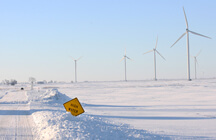Melting snow coupled with rain raises potential for flooding
February 18, 2014
 |
|
Blowing snow creates big problems for rural areas such as this section of Benton County in northwest Indiana. But much of this is expected to melt over the next few days as temperatures rise, creating the potential for flooding. (Purdue Agricultural Communication photo/Tom Campbell) |
WEST LAFAYETTE, Ind. - Indiana homeowners can take advantage of the warming weather to reduce the chance of water damage from melting snow and ice as well as rain that is expected this week, a Purdue Extension disaster education specialist says.
As snow and ice that built up around a house melts, the resulting running water can seep into the structure. That problem can be compounded by rain.
Homeowners can take steps to help the water move to a lower grade away from the house, said Steven Cain, Extension Disaster Education Network homeland security project director.
"It makes sense to take advantage of relatively good weather to channel water away from the home,'' Cain said. "Inspect the area around the home. Heat escaping there may have melted a small track against the home, and with significant rain and melting snow, this water could roll back into the home."
The National Weather Service said that as of Monday (Feb. 17), there were 4-12 inches of accumulated snow on the ground in much of central and southern Indiana, equivalent to 1 to more than 2 inches of water. It said runoff could especially be a problem because the ground is still frozen, possibly causing flooding in low-lying areas, basements, and small streams and creeks.
The weather service said there could be significant river flooding after Wednesday and that the severity of flooding would increase with heavy rainfall Thursday, combined with the potential for ice breaking up and jamming river flow.
Cain said the U.S. Geological Survey indicates that Indiana rivers and streams were at levels that would handle the snow melt and rains "if we don't get too much."
"But because of some high snowdrifts and potential ice dams blocking runoff water, we will likely have situational flooding," he said. "That could occur in a home anywhere that snow and ice are piled up around the home."
Cain offered these tips to homeowners to minimize the chance of flooding:
* Be careful not to channel water into neighbors' homes. That could be costly in terms of emotions and money as the snow melts.
* There is sure to be street flooding, so take steps to prevent water from the streets moving into your house.
* Everyone's situation is unique because of the variation in snowdrifts and potential rainfall. Use common sense to protect your home.
* Make sure you are physically up to the task of removing snow. Chipping away at ice can be very difficult. Heart attacks increase, especially in men over age 40, when removing snow.
* If flooding causes rushing water on streets or sidewalks, remember the rule: Turn around, don't drown. The depth of water is not always obvious. Street conditions could have deteriorated under the water, which could create sink holes. Even a small amount of water can sweep you off your feet. Six inches of water can stall some passenger cars and make control difficult. A foot of water can sweep many vehicles off the road.
Purdue Extension offers the free publication First Steps to Flood Recovery for homeowners. It is available at Purdue Extension's The Education Store.
Farmers and agricultural retailers can learn how to prepare for a flood by reading Plan Today for Tomorrow's Flood, also offered in The Education Store.
More flood resources are available on Purdue Extension's Floods and Storms webpage at https://ag.purdue.edu/extension/eden/Pages/flood-info.aspx.
Writer: Keith Robinson, 765-494-2722, robins89@purdue.edu
Source: Steven Cain, 765-494-8410, cain@purdue.edu
Ag Communications: (765) 494-2722;
Keith Robinson, robins89@purdue.edu
Agriculture News Page

